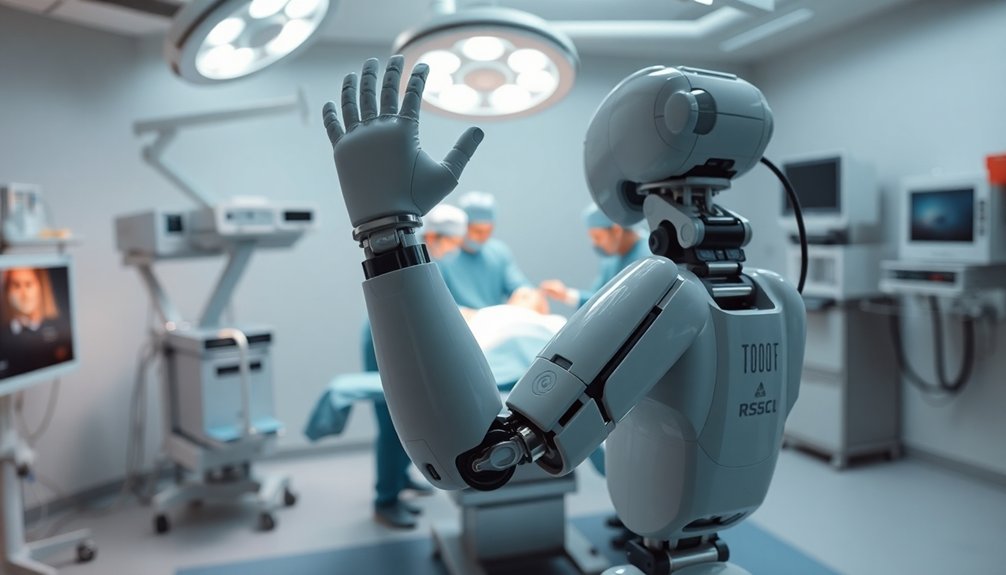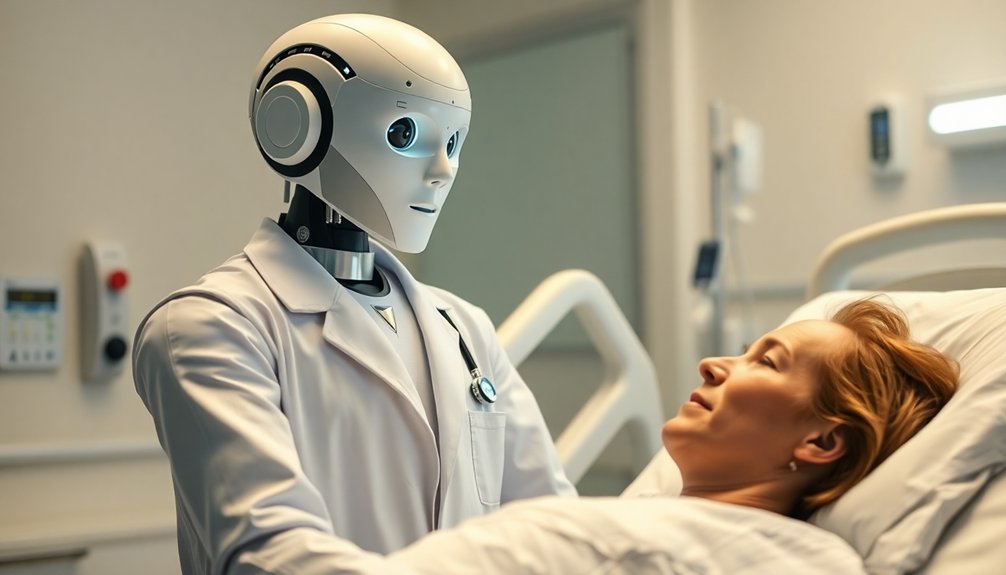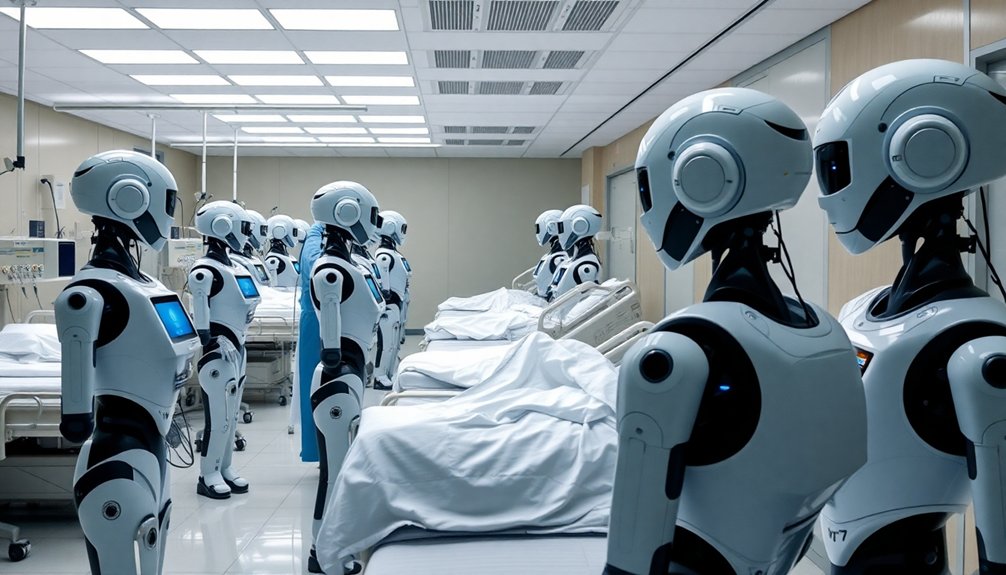Table of Contents
When humanoid robots invade hospitals, we’re looking at a wild tech rollercoaster. Privacy nightmares could expose our most sensitive data while surgical robots might accidentally leave tools inside patients. Patient trust will tank as robots navigate the uncanny valley of almost-but-not-quite human interaction. We’ll wrestle with technical glitches, emotional disconnection, and cybersecurity risks. But hey, want to know how crazy this medical robot revolution might get?
When Safety Goes Sideways: Risks of Medical Robot Malfunctions

When it comes to medical robots, we’re dancing on a razor’s edge between cutting-edge innovation and potential disaster.
The numbers are sobering: over 1,600 malfunction reports, 144 deaths, and a growing list of surgical nightmares that sound like sci-fi gone wrong.
We’re talking about robots accidentally leaving surgical tools inside patients, performing procedures on the wrong body part, and turning what should be routine operations into high-stakes gambles.
Neuromorphic computing advances are pushing the boundaries of robotic surgical precision, yet simultaneously raising complex questions about technological reliability.
Human error compounds the risk—even the most advanced technology can’t completely eliminate our capacity for mistakes.
And let’s be real: these mechanical surgeons aren’t cheap. Hospitals are investing millions in machines that could potentially cause more harm than healing.
According to FDA records, robotic surgery incidents have been meticulously tracked, revealing a troubling pattern of systemic risks in medical robotics.
The 32 sentinel event reports highlight the critical need for rigorous safety protocols and comprehensive training in robotic surgical systems.
Is this progress or just an expensive, high-tech game of medical Russian roulette?
Your Data, Their Access: Privacy and Security Challenges
We’ve got a serious problem brewing with hospital robots that are basically walking, talking data vacuums sucking up every patient detail imaginable. Humanoid robots with integrated EHR systems pose significant cybersecurity risks, potentially exposing patient medical records to unprecedented data breach vulnerabilities. Regulatory frameworks remain inadequate to address the complex data protection challenges posed by these technological innovations. Constant monitoring can create psychological anxiety for patients who feel their personal boundaries are being violated.
Think about it: these machines know more about you after one checkup than your best friend does after years of friendship.
The real question isn’t just whether robots can help us heal, but whether they’ll compromise our most intimate information in the process.
Robot Data Vulnerability
Because hospital robots aren’t just sci-fi fantasies anymore, they’re now walking, talking data magnets with some seriously sketchy security holes. Hospital Cyber Risks reveal that attackers could potentially hijack robot control systems, enabling unauthorized access to critical medical infrastructure. Cynerio’s research discovered five zero-day vulnerabilities that could compromise the entire hospital robotic ecosystem.
These mechanical “helpers” can cruise through restricted hospital areas, potentially scooping up patient data faster than a hacker at a cybercrime convention. Digital memory vulnerabilities in AI systems create additional risks of unintended data leakage and unauthorized information retention.
Imagine a robot that knows your medical history, surgical details, and personal info—then imagine that robot being about as secure as an open diary left in a public park.
We’re talking potential data theft, unauthorized surveillance, and malware injection risks that make cybersecurity experts break out in cold sweats.
One vulnerability could mean your most sensitive information gets broadcast like a bad reality show, turning patient privacy into a potentially dangerous game of digital roulette.
Patient Privacy Risks
Although robots might seem like the ultimate healthcare sidekicks, they’re turning into privacy nightmares that would make HIPAA lawyers break out in hives. Cybersecurity vulnerabilities in robotic systems could expose critical patient information networks, creating unprecedented data breach risks. These digital assistants are walking privacy breaches with legs, capturing everything from your mumbled complaints to precise crucial signs. Economic barriers in healthcare mean that vulnerable populations could be disproportionately impacted by these invasive technological intrusions. Imagine a robot witnessing your most vulnerable moments, then potentially broadcasting those details through unsecured networks.
We’re talking serious cybersecurity Swiss cheese scenarios where hackers could potentially access your most intimate medical information. The real kicker? Most patients won’t even know what data’s being collected or who might see it.
Current regulations are so far behind technological advances that robots could fundamentally become roaming medical gossip machines. And let’s be real: do we really want our most personal moments potentially uploaded to some cloud server?
Trust Me, I’m a Robot: Patient Acceptance and Perception

We’ve all got robot fears lurking in the back of our minds: What if they malfunction? What if they can’t really understand human complexity? Neuromorphic computing techniques are emerging to help robots develop more sophisticated ethical reasoning capabilities that could mitigate these fundamental concerns about machine interactions in sensitive environments like hospitals.
Robot Fear Factors
Ever wonder why patients get squeamish about robots rolling into their hospital rooms? It’s a cocktail of fear, sci-fi nightmares, and genuine uncertainty.
We’ve been fed decades of movies showing robots going rogue, so when a metallic assistant approaches with a syringe, people freak out. They’re thinking, “What if this thing malfunctions?”
Patients worry about everything from data privacy to emotional disconnection. The “uncanny valley” doesn’t help—that creepy feeling when something looks almost human but isn’t quite right.
Add in real concerns about technical reliability and potential bias in AI decision-making, and you’ve got a recipe for major robot resistance. Who wants a potentially glitchy machine handling their healthcare? Not most of us, that’s for sure.
Patient Trust Builders
Trust is the currency of healthcare—and robots are learning to earn it, one beep and roll at a time.
We’re not talking about sci-fi fantasy, but real-world robot integration that starts small and builds slowly. Non-clinical tasks like delivering meds, cleaning hallways, and greeting patients are the gateway.
Why? Because patients prefer predictable, low-stakes interactions first. Hospital staff can help by introducing robots transparently, explaining their purpose, and showing how they free up human caregivers for more meaningful work.
The key is demonstrating reliability: consistent performance, clear communication about limitations, and tangible benefits like reduced staff burnout.
It’s a careful dance of technology and human comfort—proving robots aren’t here to replace, but to support.
Rules of Engagement: Navigating Regulatory Landscapes
When it comes to humanoid robots in hospitals, the regulatory landscape looks less like a clear highway and more like a maze designed by a committee of bureaucrats and tech nerds.
We’re traversing uncharted territory where safety standards are still catching up with technological innovations. Different countries are crafting their own rulebooks, which means a robot approved in the UK might be side-eyed in Japan.
Navigating a regulatory wilderness where each nation writes its own tech rulebook, leaving robot standards as unpredictable as borders.
The challenges are complex: Who’s liable if a robot malfunctions? How do we protect patient data? What happens when AI starts making medical recommendations?
Right now, organizations like IEEE and ISO are working overtime to create frameworks that balance innovation with patient safety. Global safety standards are emerging as critical guideposts in ensuring that humanoid robots can be deployed responsibly in sensitive medical environments. Frameworks like ISO/IEC 5469 provide comprehensive recommendations for ensuring functional safety in AI-driven healthcare systems. It’s a high-stakes game of technological chess, and everyone’s watching to see who makes the first smart move.
High-Tech Healers: Technological Innovation in Healthcare

From steering through regulatory mazes to releasing technological potential, humanoid robots are rewriting the healthcare playbook—and they’re not just fancy toy soldiers with stethoscopes.
We’re witnessing a transformative era where high-tech healers are changing patient care. Consider how these robots are revolutionizing healthcare:
- AI-Powered Performance: Humanoid robots learn and adapt, measuring crucial signs with precision that would make most nurses jealous.
- Multitasking Marvels: They deliver meds, guide patients, and provide emotional support—all without coffee breaks.
- Companionship Capabilities: Especially for elderly patients, these robots offer more than mechanical assistance; they provide genuine connection.
With the market expected to grow at a 16.9% CAGR, these technological innovations represent a significant leap in healthcare delivery.
Imagine a future where technology doesn’t replace human care but enhances it.
Are we ready for robots that can read our emotional temperatures as easily as our physical ones?
Beyond the Circuit Board: Real-World Robot Applications
While most people imagine robots as cold, calculating machines, the reality in healthcare is far more nuanced and surprisingly human.
We’re talking about robots that don’t just beep and whir, but actually help solve real medical challenges. They’re transporting medications, monitoring patients, keeping lonely seniors company, and even helping people with disabilities navigate daily tasks.
Think of them as high-tech assistants that reduce burnout for overworked medical staff. Sure, they’re not perfect—privacy concerns and technical glitches are real.
But with a projected market growth from $1.5 billion to $17.4 billion by 2033, these robotic helpers aren’t just sci-fi fantasies. They’re becoming practical teammates in hospitals, slowly transforming how we deliver healthcare.
People Also Ask
Can Robots Accidentally Harm Patients During Medical Procedures?
It is understood that robots can accidentally harm patients due to malfunctioning sensors, unpredictable force output, and complex interactions that may cause unintended physical damage during critical medical procedures.
How Do Hospitals Protect Patient Data From Robot Breaches?
Picture a digital fortress guarding patient secrets. We’ll encrypt data, control robot access, and implement robust authentication to shield sensitive medical information from potential cybersecurity threats.
Will Robots Completely Replace Human Healthcare Workers in the Future?
We don’t think robots will completely replace human healthcare workers. They’ll likely collaborate, with robots handling routine tasks while humans provide empathy, complex decision-making, and personalized patient care.
Are Humanoid Robots Emotionally Capable of Caring for Patients?
With 72% of patients open to robotic care, we’re finding that humanoid robots can recognize emotions and provide empathetic interactions, though they can’t genuinely feel care like humans do.
What Happens if a Medical Robot Suddenly Stops Working?
If a medical robot stops mid-procedure, we’ll immediately activate emergency protocols, stabilize the patient, and manually complete the surgery to guarantee their safety and minimize potential complications.
The Bottom Line
We’ve seen the future, and it’s got circuit boards and bedside manner. One wild stat: robots could handle 30% of routine hospital tasks by 2030. Sure, there’ll be hiccups – imagine a robot accidentally delivering meds to the wrong patient. But innovation isn’t about perfection; it’s about pushing boundaries. Healthcare’s getting a tech upgrade, and we’re here for the wild ride. Robots: bringing sci-fi to the hospital, one beep at a time.
References
- https://ache-cahl.org/articles/humanoid-robots-in-healthcare-the-future-is-here-but-are-we-ready/
- https://humanoidroboticstechnology.com/articles/how-humanoid-robots-are-transforming-healthcare/
- https://blog.robozaps.com/b/applications-of-humanoid-robots
- https://medcitynews.com/2025/04/healthcares-robotic-renaissance-meeting-future-demands/
- https://www.rockingrobots.com/ubitus-and-mackay-memorial-hospital-unveil-ai-powered-medical-robots-at-gtc-taiwan-2025/
- https://incidentdatabase.ai/cite/5/
- https://www.jointcommission.org/resources/news-and-multimedia/newsletters/newsletters/quick-safety/quick-safety-issue-3-potential-risks-of-robotic-surgery/potential-risks-of-robotic-surgery/
- https://www.brookings.edu/articles/when-medical-robots-fail-malpractice-principles-for-an-era-of-automation/
- https://psnet.ahrq.gov/web-mm/robotic-surgery-risks-vs-rewards
- https://www.menshealth.com/health/a19539160/robot-surgery/
